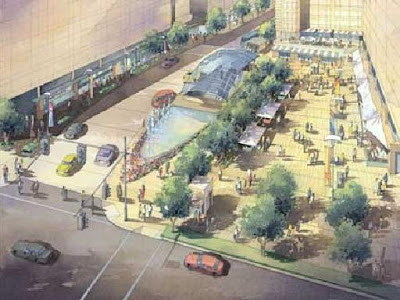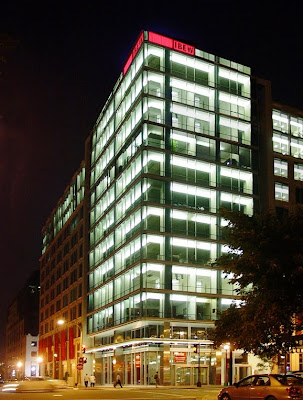
100 years ago today, Congress passed the
Heights of Buildings Act of 1910, a law that has done more than any other to shape the physical environment of Washington DC. The effect has been dramatic - not just on heights - but on architecture, density, land values, even on the city's collective psyche. Much has changed in the intervening century, but the rules have been modified little.
In honor of the June 1st centennial,
DCMud will look at the issue of density and DC's height limits, presenting varying opinions on its effects, architecture, and desirability.
 A History
A HistoryNo, the height limits are not based on the height of the Capitol dome (at 289 feet high, the 5th tallest structure in the city), a persistent myth. Instead, the 164-foot
Cairo Apartment Building (subsequently the Cairo Hotel, now a condo) at 1615 Q Street, NW, aroused the reactionary rules when architect
Thomas Franklin Schneider built the Egyptian-inspired building in 1894. Responding to petitions, city Commissioners issued rules limiting building heights, later codified by Congress in the
Heights of Buildings Act of 1899, setting maximum height of 110 feet for business and 90 feet for residential projects. The
1910 Act modified the law in several important respects, most notably by permitting heights to rise not past 130 feet, but setting a formula to determine site-specific maximum heights equal to the fronting street width plus 20 feet, judged from the sidewalk, though many sites are sub-zoned for still lower density. An exception still exists for such architectural embellishments as spires and belfries.
Much has changed since 1894 when the Cairo ignited the debate - when
Grover Cleveland was President, DC's Commissioners were unelected, and the District didn't even have a vote in Congress (
imagine). Few DC denizens are now as shocked by the height of the Cairo as were their 19th-century predecessors. Building construction has progressed dramatically beyond the steel-frame and limestone-brick pile architecture of the Cairo. Firefighting ability, an issue when the Cairo crested above the reach of fire ladders, has likewise adapted to higher structures.
The Plan
Given L'Enfant's sacrosanctity, it should be noted that building height limits at the time the L'Enfant plan was adopted, naturally low due to construction limitations, were never officially part of his creation. Parisian
Pierre L'Enfant envisioned the sprawling, low-flung buildings and wide boulevards of his native capital, while President Thomas Jefferson, an extreme Francophile, also dreamed of Paris on the Potomac, providing L'Enfant with inspirational maps of European cities with buildings that hugged the ground (wanting buildings "low & convenient, and the streets light and airy"). Still, formal limits or guidelines were never established.
With the march of technology, the District's earliest architects were without compunction in designing buildings to the upper edge of physical limitations, with no apparent regard for nostalgia. Some of the earliest buildings reached upward unhesitatingly - The
Smithsonian Institution Building (begun 1847, 145 feet),
Healy Hall of Georgetown (begun 1879, 200 feet), the
Old Post Office Building (begun 1891, 315 feet), and of course the U.S. Capitol Building (298 feet).
That Was Then
Proponents of change point to the ever taller buildings creeping up literally on the DC border in
Silver Spring,
Rosslyn (
see Central Place, at right),
Alexandria, and
Chevy Chase, and with them architecture, development, residents, jobs, and city views denied to DC. Urban planners, preservationists and greenies alike argue for greater density ("if you love the country, live in the city"), a position that also offers a strong economic punch while slowing sprawl. That the law is imposed from without raises the neck fur of DC's voting rights activists who prefer a little more self- determination than that.
Yet it must be admitted that DC is not just another urban environment

devoid of national significance. Its existence owes to the founders' desire for an independent district; a national model as a symbol of democracy and showpiece for America's (then) novel experiment. DC is, after all, the only city designated by the U.S. Constitution.
Others prefer DC's uniquely stubbly skyline, greater green canopy, and open, sunny streets. Height limits provide a backstop (if also an upper limit) for property values, limiting developable land and with it competition for developers and landowners. And whatever its initial demerits, DC's low-rise viewscape has become part of its identity as a livable, European-style metropolis.
An Experiment Subject to Change?If both arguments have some potency, are the two sides condemned to an

intractable, Whitehurst-like eternal battle over the issue? Compromise, if there were to be any, would be unlikely to radically change the downtown federal core in an era of accelerating security. Nor are residents of historic neighborhoods like Georgetown or Capitol Hill clamoring for towers in their midst. Others, however, have painted themselves as underserved by the development community, retailers, and entrepreneurs. Marshall Heights and Deanwood - farther from the Capitol building than Rosslyn - have limited claims on the character of DC's downtown skyline. Advocates in both neighborhoods have bemoaned the lack of investment, retail and
sit-down restaurants. Taller buildings don't remedy such shortcomings intrinsically but, carefully planned, can increase density to a tipping point that attracts other economic investment.
Raising height limits in select locations could alter the investment dynamic in overlooked neighborhoods, creating

entrepreneurial zones, a concept that has worked in numerous struggling cities. Washington DC's "Gateway" avenues present a vexing argument against the status quo: wide, heavily trafficked streets with commercial cores, Metro stations, and less restricted buildings heights one stoplight away. Paris, after all, has Le Defense (
at right), a skyscraper-friendly district which only serves to underscore the aesthetics of central Paris and serve as an economic engine for the city of light.
DC has several such zones. East Capitol Street at the PG County border presents a high-speed thoroughfare, Metro station, and yet struggles to find the investment capital to finance its projects. Absent a
raison d'etre,
 Capitol View Park Towers
Capitol View Park Towers (
at left) and
Capitol Gateway struggle for existence in a low-density neighborhood, with development on hold.
Georgia Avenue at the Silver Spring border is a dream case study. Farther from the Capitol building than Old Town Alexandria, the two Georgias present a stark contrast - downtown Silver Spring, where painstaking planning has led to a dense and finally vibrant, livable urban core - and its DC root, which lives up to (and then some) its south-of-the-border locale.

Wisconsin Avenue at the city's northwestern terminus presents a different contrast. While the corridor does not want for high-end retail,
apartment buildings, office towers,
retail,
hotels and
supermarkets are springing up on the Chevy Chase Maryland side, while on the District's flank development languishes, save an
undersized, wood-framed condo, sneaking in by not seeking increased density. Lots above the metro sit vacant or bear empty two-story parking pads, or serve as surface parking for a bus depot. Attempts at development, in spite of zoning approval, are allowed to be
vetoed by single-interest groups
who protest heights less than half those that exist two blocks north. Density caps on each of the lots render them not quite ripe for development.
Opponents of change need not worry about 50 stories rising in their Palisades backyard or soaring towers blocking off the Mall. The District's zoning authorities would administer appropriate zones for increased height, historic protection, architectural review and case-by-case examination. Modifying the height ban would, in any event, allow the District to make such determinations, making this debate not just an academic one.

 When is a groundbreaking not a groundbreaking? Perhaps when the project is already well under way and a small box of dirt serves as shovel fodder on the rooftop of a nearby
When is a groundbreaking not a groundbreaking? Perhaps when the project is already well under way and a small box of dirt serves as shovel fodder on the rooftop of a nearby  building, which was the scene at today's groundbreaking at 733 10th Street, NW. Still, progress is progress, and the new 10-story, 200,000 s.f. Skanska building at 10th and G Streets, NW, will change the face of the site that neighbors the MLK Library. According to Robert Ward, Executive Vice President at Skanska, the new structure should top out by the end of the year.
building, which was the scene at today's groundbreaking at 733 10th Street, NW. Still, progress is progress, and the new 10-story, 200,000 s.f. Skanska building at 10th and G Streets, NW, will change the face of the site that neighbors the MLK Library. According to Robert Ward, Executive Vice President at Skanska, the new structure should top out by the end of the year. Ward and his team stepped into the picture and have been working with PNHoffman and the congregation to rework the plan for the downtown site for almost a year. Skanska now acts as the developer, financier and general contractor with PNHoffman as non-financing partner.
Ward and his team stepped into the picture and have been working with PNHoffman and the congregation to rework the plan for the downtown site for almost a year. Skanska now acts as the developer, financier and general contractor with PNHoffman as non-financing partner. ed green roof and hexagonal glass facade - from the fourth floor up. Upwards of 4,000 s.f. of ground floor retail will be a "nice enhancement" for the neighborhood, according to Ward, who hopes to secure a restaurant tenant. Delivery is expected by October of 2011, with development costs around $85 million.
ed green roof and hexagonal glass facade - from the fourth floor up. Upwards of 4,000 s.f. of ground floor retail will be a "nice enhancement" for the neighborhood, according to Ward, who hopes to secure a restaurant tenant. Delivery is expected by October of 2011, with development costs around $85 million.



















































